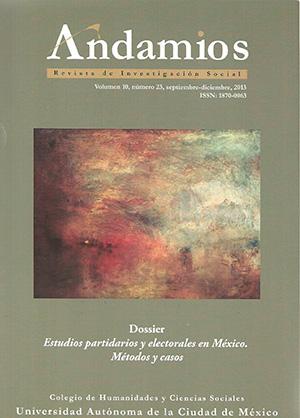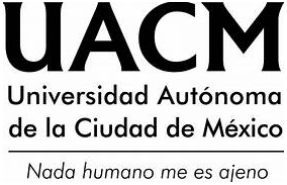The Prisoner’s Tattooed-Body as a Discursive Space
DOI:
https://doi.org/10.29092/uacm.v10i23.258Keywords:
Prison, Body, Tattoo, Discourse, Social PsychologyAbstract
The intention of this article is to show the results of a research that takes place in a penitentiary of Guanajuato State, Mexico. The theory and methodology that sustain this study is the critical social psychology, base of the Master Degree of Social Psychology on the Universidad Autónoma de Querétaro, Mexico. The conclusion is that the prisoner-subject involved in the routine, anonymity and lack of outlets to talk, chose tattoo his own body as a space of discourse, where can give significant and make sense of himself, of the situation he live, and also the leave permanent mark of his own story.
Downloads
References
Aguirre, A. y Rodríguez, A. (1995), Patios abiertos y patios cerrados, México: Alfaomega marcombo.
Amuchástegui, A. y Parrini, R. (2007), “Sexualidad, identidad y ciudadanía en el México contemporáneo”, artículo en línea disponible en http://www.metapolitica.com.mx/?method=display_articulo&idarticulo=736&idpublicacion=1&idnumero=48consultado el 29 de mayo de 2011.
Austin, J. (1962), Cómo hacer cosas con palabras, Barcelona: Paidós.
Baratta, A. (1986), Criminología crítica y crítica del derecho penal, México: Siglo XXI.
Benveniste, E. (1970), “L’appareil Formel de l’enunciation”, en A. Rey, Theories du signe et du sens, París: Klincksieck, p. 172-179.
Bergalli, R. (1980), La recaída en el delito: modos de reaccionar contra ella, Barcelona: Sertesa.
Berger, P. y Luckmann, T. (1983), La construcción social de la realidad, Buenos Aires: Amorrortu.
Billig, M. (1990), “Memoria colectiva, ideología y la familia real británica”, en, D. Middleton y E. Edwards (comps.), Memoria compartida. La naturaleza social del recuerdo y del olvido, Barcelona: Paidós. p. 77-96.
_______ (1991), Ideology and Opionions: Studies in Rhetorical psychology, Londres: Sage.
Saussure, F. (1945), Curso de lingüística general, Buenos Aires: Lozada.
Fernández, P. (1994), La psicología colectiva un fin de siglo más tarde, Colombia: Anthropos/El Colegio de Michoacán. Filinich, M. (1998), Enunciación, Argentina: Eudeba.
Foucault, M. (1974-1975), Los anormales, México: FCE.
__________ (1975), Vigilar y castigar, México: Siglo XXI.
Freud, S. (1913), “Tótem y Tabú”, en Sigmund Freud, Obras Completas, tomo XIII. Argentina: Amorrotu, p. 1-164.
Friedlander, K. (1950), Psicoanálisis de la delincuencia juvenil, Argentina: Paidós.
Ganter, R. (2005), “De cuerpos, tatuajes y culturas juveniles”, artículo en línea disponible en: http://redalyc.uaemex.mx/redalyc/pdf/122/12214102.pdf consultado el 28 de abril de 2007.
Giddens, A. (1991), Modernidad e identidad del yo, Barcelona: Península.
Goff man, E. (1961), Internados. Sobre la situación social de los enfermos mentales, Argentina: Amorrortu.
Halbwachs, M. (1968), La Mémorie Collective, París: Presses Universitaires de France.
Ibáñez, T. (1989), “La psicología social como dispositivo desconstruccionista”, en T. Ibáñez (coord.), El conocimiento de la realidad social, Barcelona: Sendai, p. 109-133.
Íñiguez, L. (2003), Análisis del discurso. Manual para las ciencias sociales, Barcelona: Universitat Oberta de Catalunya.
Lacan, J. (1971), “Introducción teórica a las funciones del psicoanálisis en criminología”, en Jaques Lacan, Escritos 1, México: Siglo XXI, p. 117-141.
Marchiori, H. (1975), Psicología criminal. Personalidad del delincuente, México: Porrúa.
Payá, V. (2006), Vida y muerte en la cárcel. Estudio sobre la situación institucional de los prisioneros, México: UNAM/Plaza y Valdés.
Pinatel, J. (1969), ¿La prisión puede transformarse en institución de tratamiento?, Francia: Anales Internacionales de Criminología.
Piña, M. (2004), “El cuerpo un campo de batalla. Tecnologías de sometimiento y resistencia en el cuerpo modificado”, artículo en línea, disponible en http://redalyc.uaemex.mx/redalyc/ html/325/32512621/32512621.html consultado el 18 demarzo de 2011.
Presidencia de la República (2007), “Primer informe de gobierno. Apartado sobre Estado de Derecho y Seguridad”, artículo en línea disponible en http://primer.informe.gob.mx/1.3_SEGURIDAD_
PUBLICA/?contenido=159, consultado el 7 de febrero de 2011.
Reason, Ch. y Kaplan, R. (1975), “The Down the Walls? Some Functions of Prisons”, en Crime & Delinquency, octubre, p. 360-372.
Rivera, C. (2010), La Castañeda. Narrativas dolientes desde el Manicomio General, México: Tusquets.
Salillas y Panzano (1910), “El tatuaje y el destatuamiento en Barcelona”, conferencia en el Ateneo de Madrid el 9 de junio de 1910. Biblioteca de la Universidad de Barcelona s.n., (Tip. La Académica).
Tatoo Odin (2011), “Historia del Tatuaje”, artículo en línea disponible en: http://www.eltatuaje-odin.com/historia_tatuaje.asp consultado el 18 de marzo de 2011.
Velázquez, A. (2013), Experiencia concentracionaria: entre la muerte del lenguaje y su testimonio, México: Fundap.
Vico, G. (1725), Autobiografía, Argentina: Austral.
Wetherell, M. y Potter, J. (1992), Mapping the lenguage of racism, Oxford: Harvester.
Published
Issue
Section
License
This Journal is licensed under Creative Commons Mexico 2.5. It is allowed to reproduce and disseminate the contents of the Journal for educational or research purposes, not for profit, as long as they are not mutilated and cite the source (Andamios, Revista de Investigación Social) and the author.
The copyright of the articles published in Andamios, Revista de Investigación Social are transferred by the author(s) to Universidad Autónoma de la Ciudad de México when the originals have been accepted, so that they are published and distributed both in the printed and electronic versions of the Journal. However, as established by law, the author(s) retains their moral rights. The author(s) will receive a form of assignment of copyright that they must to sign when their original has been accepted. In the case of collective articles, the signature of one of the authors will suffice, provided that the latter has obtained the consent of the others.
Authors may use the material of their article in other works or books published by themselves, with the condition of quoting Andamios as the original source of the texts.
The articles contained in this publication are the responsibility of their authors and do not compromise the official position of Andamios, Revista de Investigación Social of the Universidad Autónoma de la Ciudad de México.


